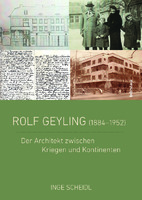Rolf Geyling (1884-1952)
Der Architekt zwischen Kriegen und Kontinenten
| dc.contributor.author | Scheidl, Inge | |
| dc.date.accessioned | 2014-12-31 23:55:55 | |
| dc.date.accessioned | 2020-01-30 13:42:05 | |
| dc.date.accessioned | 2020-04-01T14:39:18Z | |
| dc.date.available | 2020-04-01T14:39:18Z | |
| dc.date.issued | 2014 | |
| dc.identifier | 507999 | |
| dc.identifier | OCN: 979971035 | en_US |
| dc.identifier.uri | http://library.oapen.org/handle/20.500.12657/33296 | |
| dc.description.abstract | This publication documents the life and work of the architect Rolf Geyling (1884-1952), who was a former student of Otto Wagner and started his career in Vienna and Bucharest before the First World War broke out. During the war Geyling documented his experiences as an officer of the Habsburger Monarchy with photographs and a detailed diary, which he continued during his imprisonment in Siberia. After five years in several camps - most recently in Vladivostok - Geyling fled to Tianjin in China, where he successfully established himself as an architect until the period of Mao Tse-tung and was particularly involved in the development of modern architecture in northern China. | |
| dc.language | German | |
| dc.subject.classification | thema EDItEUR::A The Arts::AM Architecture | en_US |
| dc.subject.other | Architecture | |
| dc.subject.other | Historicism | |
| dc.subject.other | Art Nouveau | |
| dc.subject.other | New Objectivity | |
| dc.subject.other | World War | |
| dc.subject.other | Eastern Front | |
| dc.subject.other | Captivity | |
| dc.subject.other | Siberia | |
| dc.subject.other | China | |
| dc.subject.other | Tianjin | |
| dc.subject.other | Architektur | |
| dc.subject.other | Historismus | |
| dc.subject.other | Jugendstil | |
| dc.subject.other | Neue Sachlichkeit | |
| dc.subject.other | Erster Weltkrieg | |
| dc.subject.other | Ostfront | |
| dc.subject.other | Kriegsgefangenschaft | |
| dc.subject.other | Sibirien | |
| dc.subject.other | China | |
| dc.subject.other | Tianjin | |
| dc.subject.other | Russland | |
| dc.subject.other | Wien | |
| dc.title | Rolf Geyling (1884-1952) | |
| dc.title.alternative | Der Architekt zwischen Kriegen und Kontinenten | |
| dc.type | book | |
| oapen.abstract.otherlanguage | Die vorliegende Publikation dokumentiert das Leben und Werk des Architekten Rolf Geyling (1884-1952), der als ehemaliger Schüler Otto Wagners in Wien und Bukarest tätig war, ehe der Erste Weltkrieg ausbrach. Seine Erlebnisse als k. u. k. Offizier dokumentierte Geyling mit Fotografien sowie detaillierten Tagebuchaufzeichnungen, die er auch während seiner Gefangenschaft in Sibirien fortsetzte. Nach fünfjährigem Aufenthalt in mehreren Lagern - zuletzt in Wladiwostok - floh Geyling nach Tianjin in China, wo er sich ab 1920 bis zur Machtübernahme Mao Tse-tungs erfolgreich als Architekt etablieren konnte und an der modernen Architekturentwicklung Nordchinas wesentlichen Anteil hatte. | |
| oapen.identifier.doi | 10.26530/oapen_507999 | |
| oapen.relation.isPublishedBy | af16fd4b-42a1-46ed-82e8-c5e880252476 | * |
| oapen.relation.isFundedBy | 26ae1657-c58f-4f1d-a392-585ee75c293e | |
| oapen.relation.isbn | 9783205795858 | |
| oapen.collection | Austrian Science Fund (FWF) | |
| oapen.imprint | Böhlau | |
| oapen.pages | 290 | |
| oapen.grant.number | PUB 143 | |
| oapen.remark.public | Relevant Wikipedia pages: Russland - https://de.wikipedia.org/wiki/Russland; Tianjin - https://de.wikipedia.org/wiki/Tianjin; Wien - https://de.wikipedia.org/wiki/Wien | |
| oapen.identifier.ocn | 979971035 |

